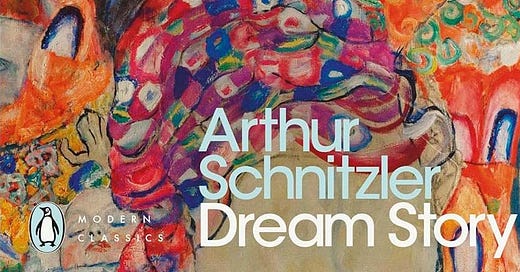7. Arthur Schnitzler – Dream Story (1926)
This novella was famously adapted by Stanley Kubrick for ‘Eyes Wide Shut.’ I personally don’t remember much about that movie, other than thinking ‘what the hell was that about?’ Twenty years on, I approached this book with a more open mind. It’s called ‘Dream Story’ after all, so I accepted from the off that it probably wasn’t seeking to set out a narrative in the traditional sense. The whole thing hovers in liminal space. The book opens with a doctor called Fridolin in his safe domestic environment, alongside his beloved wife Albertine, reading a bedtime story to their child. Then, under the guise of a house call, he goes out to roam the nighttime streets of Vienna and has a series of puzzlingly disparate encounters – most notably at a masked sex party on the outskirts of the city. These forays into the dark underworld of Vienna can be seen as a metaphor for the rumblings of his own darker hidden desires. During a brief return to the house, Albertine recounts an explicit dream – confessing, in her turn, to disturbing sub-surface thoughts that cannot be confined by marriage and motherhood. The author offers breadcrumb clues that this wispy narrative may not be everything it seems: Albertine’s dream man is a Dane. Fridolin’s secret password to the sex club is ‘Denmark’.
Schnitzler was considered very risqué in his time – indeed one of his plays, La Ronde, was banned by censors (before becoming, many decades later, a West End hit re-written by David Hare as The Blue Room). Sex and the sexual impulse looms very large in this story, but it’s not the tale of a cheating husband, as neither Fridolin nor Albertine act upon their desires. Instead, they both entertain, often out loud to one another, the idea of infidelity, which seems to give their marriage a sexual frisson. I certainly found this more erotic than the far more overtly sexual Anaïs Nin book I reacted to a couple of weeks ago. Less is more.
As a trained doctor and contemporary of Sigmund Freud, Schnitzler’s book must be seen in the context of new theories about dreams and the subconscious. In the introduction to my edition, Frederic Raphael points out that ‘traum’, the German word for dream, has the same root as our word for trauma – the lasting, largely subconscious emotional by-product of distressing events. As such, Schnitzler paints the image of a newly uncertain post World War I society ‘where, beneath the elegant surface, irrational motives made nonsense of constancy and a comedy of morals.’ I found this short book thought provoking, strange and beautiful.




